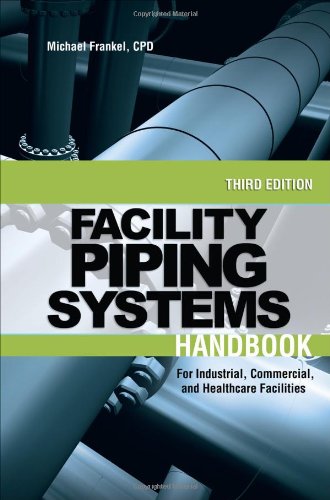Product desciption
Facility Piping Systems Handbook For Industrial Commercial And Healthcare Facilities 3rd Edition Michael Frankel by Michael Frankel 9780071597210, 0071597212 instant download after payment.
Facility Piping Systems Handbook for Industrial, Commercial and Health Care Applications by Frankel McGraw Hill Publishers 2010 Reviewed by: Dr. Joseph S. Maresca The work begins with an exhaustive list of professional institutes related to the topic of piping systems and processes. Examples of the governing institutes are: o American Gas Institute o American Petroleum Institute o American Society of Testing / Materials and a host of others There are codes for piping systems, allowable materials, stresses, seismic loads, thermal heat expansion, fabrication, installations and testing. The topic of corrosion is discussed extensively. Corrosion resistance is the ability of the pipe to resist internal corrosive effects of fluid flow throughout , as well as external corrosive flows on the pipe itself . i.e. soils and the surrounding atmospheric conditions Corrosion can be reduced or eliminated with suitable coatings, linings and cathodic protection . Cathodic protection has become a widely used method for controlling the corrosion deterioration of metallic structures in contact with most forms of electrolytically conducting environments. Cathodic protection reduces the corrosion rate of a metallic structure by reducing its corrosion potential, bringing the metal closer to an immune state. General corrosion describes pipe dissolution over the entire exposed surface where localized corrosion resides in a small area of the pipe. Corrosive cracking is the physical deterioration and cracking of pipe wall due to increased operating temperature, tensile stress on the pipe and chemicals. The author describes water impurities like turbidity (insolubles) , bacteria and viruses. Tensile stress occurs when a material undergoes a pulling or stretching force. Stress is defined as a force applied over a cross-sectional area in typical units of pounds per square inch (psi) or Newtons per square meter. The type of stress that a material is exposed to will depend on how the force is being applied. The three basic types of stress are tensile, compressive, and shear. The maximum tensile stress that a material can withstand before failure is known as tensile strength . The value of ultimate tensile strength varies widely for different materials. Soft, malleable materials like many plastics, rubber, and metals are considered elastic and will undergo significant deformation before a complete failure occurs. Hard and brittle materials, like concrete and glass, have little or no deformation before complete failure. The ultimate tensile strength for many different types of concrete, plastics, metal, wood, glass, rubber and ceramics is fairly described in manuals; such as this one. Double wall piping involves the installation of outer pipe around an inner pipe which prevents the release of hazardous liquids being transported in the inner pipe. Typical valve design considerations are temperature, pressure, shutoff valve operation, pressure drops, corrosive resistance, velocity, fire safety and hazardous materials. Generally, no machine should be designed without the ability to shut it down by some means either electrical, mechanical or otherwise. In addition, some applications are constructed with redundant and tridundant capabilities to address contingency modes. There is an extensive section on insulation which includes fiberglass, cellular glass,expanded plastic foam, foamed plastic, calcium silicate, mineral fiber and insulating cement. Overall, the volume enunciates a fairly complete rendition of applicable fluid principles and materials science structure of matter intertwined with the relevant standards setting authorities who promulgate standards for the engineering and allied professions . This acquisition would be perfect for the engineering professional in your household. Students of engineering fluid mechanics will find this volume useful for exams and projects.


